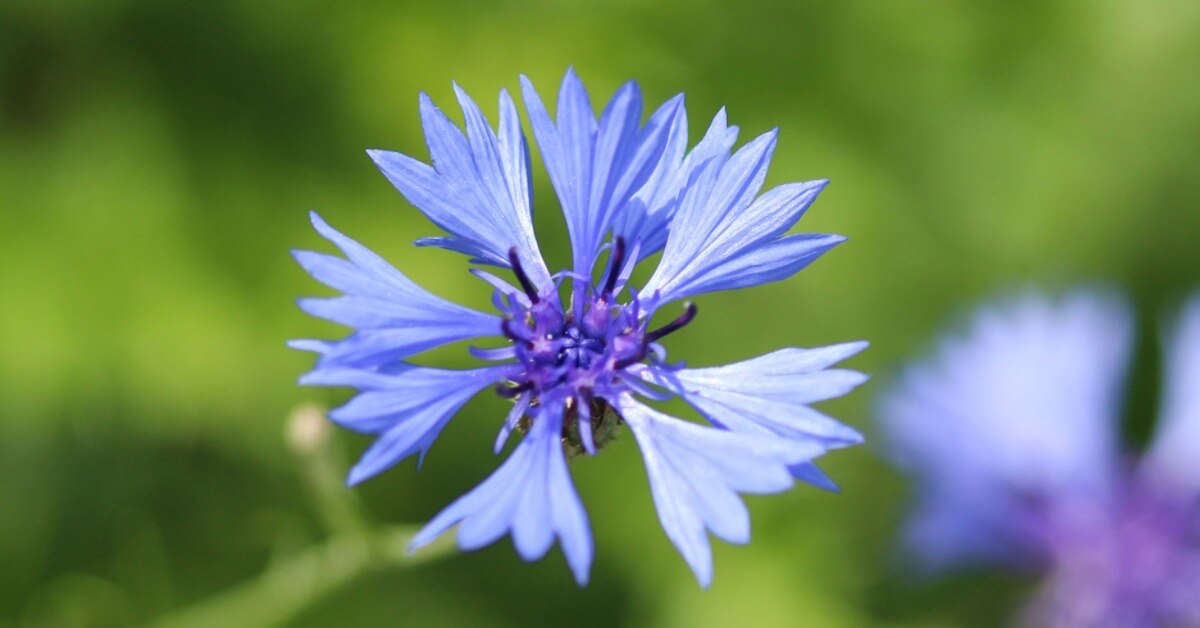Nature’s vibrant tapestry comes to life through the myriad of flowers that grace our gardens and landscapes. Among this diverse array of botanical wonders, a particular letter stands out in its contribution to the world of blossoms.
The letter ‘B’ is synonymous with beauty, representing a wide spectrum of floral species that captivate with their colors, shapes, and scents. In this article, we embark on a delightful journey through 30 Flowers That Start with B.
List of Flowers That Start with B
- Bletilla (Bletilla striata)
- Bishop’s Hat (Epimedium spp.)
- Bloodroot (Sanguinaria canadensis)
- Butterfly Bush (Buddleja spp.)
- Basket of Gold (Aurinia saxatilis)
- Bee Plant (Cleome serrulata)
- Blue Hibiscus (Alyogyne huegelii)
- Belladonna Lily (Amaryllis belladonna)
- Beardtongue (Penstemon spp.)
- Blue Passion Flower (Passiflora caerulea)
- Begonia (Begonia spp.)
- Bluebell (Hyacinthoides non-scripta)
- Bougainvillea (Bougainvillea spp.)
- Buttercup (Ranunculus spp.)
- Bleeding Heart (Dicentra spectabilis)
- Bee Balm (Monarda didyma)
- Balloon Flower (Platycodon grandiflorus)
- Borage (Borago officinalis)
- Black-eyed Susan (Rudbeckia hirta)
- Bee Orchid (Ophrys spp.)
- Bird of Paradise (Strelitzia reginae)
- Blanket Flower (Gaillardia spp.)
- Bellflower (Campanula spp.)
- Bachelor’s Button (Centaurea cyanus)
- Blephilia (Blephilia spp.)
- Blazing Star (Liatris spp.)
- Baby’s Breath (Gypsophila spp.)
- Balsam (Impatiens balsamina)
- Beehive Ginger (Zingiber spectabile)
- Brazilian Plume Flower (Justicia carnea)
Bletilla (Bletilla striata)
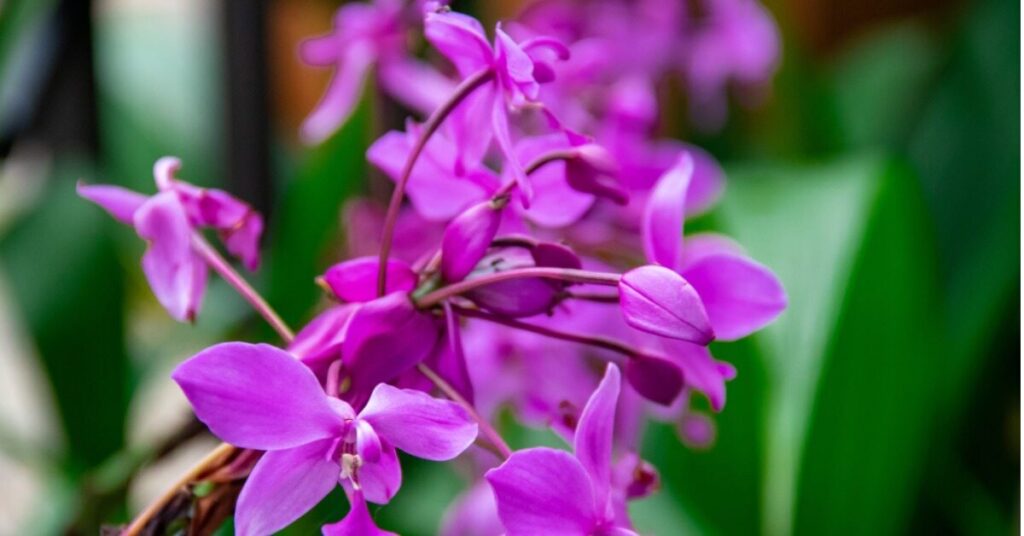
Bletilla, commonly known as the Chinese Ground Orchid, is an exquisite and hardy terrestrial orchid. It produces delicate, lilac-purple, and occasionally white, orchid-like flowers in spring. Each stem can carry multiple blooms, and they resemble miniature Cattleya orchids. Bletilla is native to East Asia and is surprisingly easy to grow in temperate regions. It prefers well-draining soil, part shade to dappled sunlight, and consistent moisture. This orchid is treasured for its graceful appearance and unique charm, making it a delightful addition to shaded gardens. It’s a great flower for any home or garden.
- Watering Needs: Keep the soil consistently moist during the growing season, then reduce watering when dormant.
- Bloom Color: Lavender-purple, occasionally white.
- Hardiness Zones: 5-9.
- Mature Height: 1-2 feet.
- Bloom Time: Spring.
- Sunlight Exposure: Part shade to dappled sunlight.
Bishop’s Hat (Epimedium spp.)
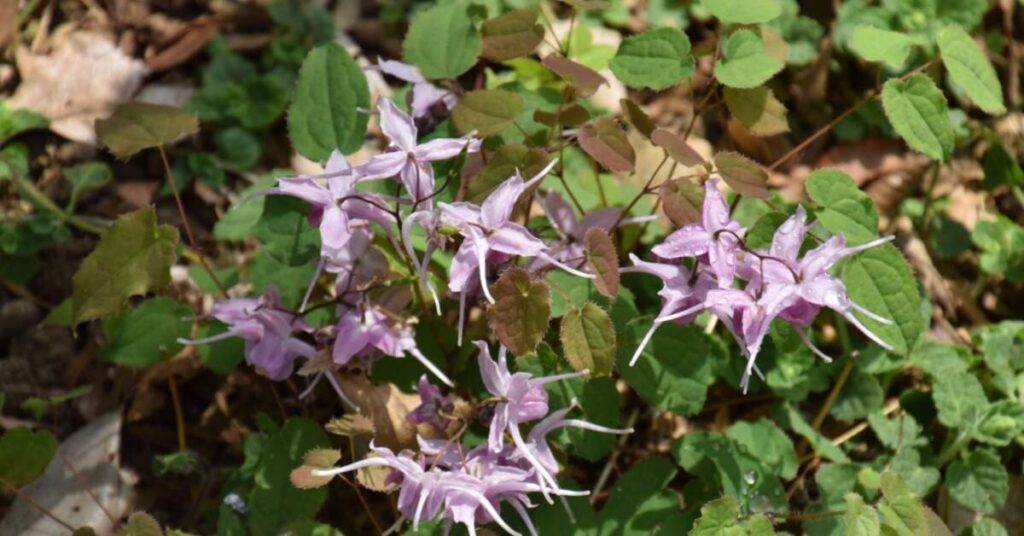
Bishop’s Hat, also known as Barrenwort, is a low-growing perennial plant that belongs to the Berberidaceae family. Its delicate, heart-shaped leaves and dainty, spurred flowers give it a distinctive appeal. The flowers appear in shades of pink, white, or yellow, depending on the species. Bishop’s Hat is valued for its adaptability to shade, making it an excellent choice for woodland gardens. It is also a hardy plant, suitable for various climates, and often utilized for ground cover due to its attractive foliage and early spring blooms.
- Watering Needs: Moderate watering, well-draining soil.
- Bloom Color: Varies by species, pink, white, or yellow.
- Hardiness Zones: 4-9, depending on the species.
- Mature Height: 6-18 inches.
- Bloom Time: Spring.
- Sunlight Exposure: Part shade to full shade.
Bloodroot (Sanguinaria canadensis)
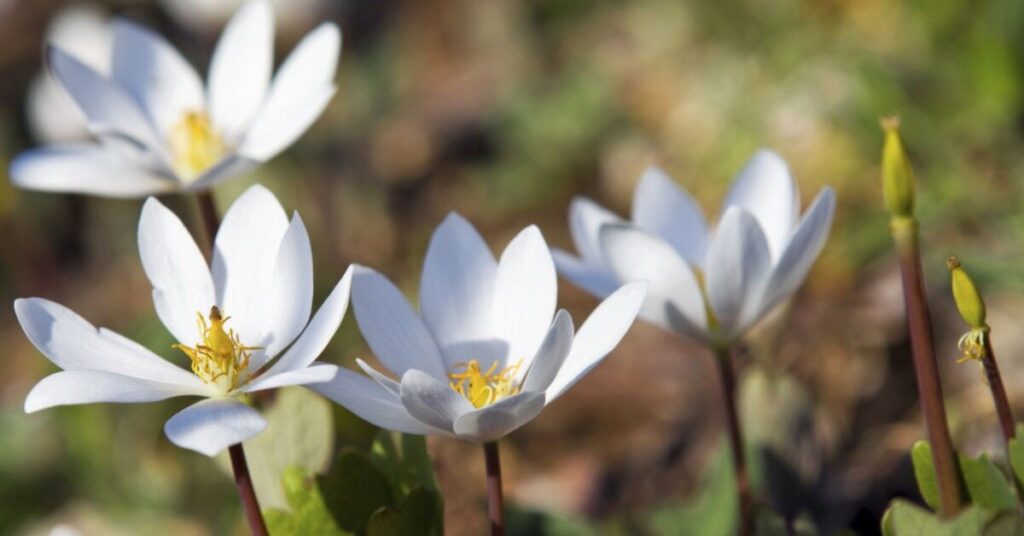
Bloodroot is a native North American wildflower that stands out for its striking white flowers and distinctive lobed leaves. The plant gets its name from the red sap found in its rhizomes, which was historically used by Native Americans for various purposes. Bloodroot blooms in early spring, featuring single, large, white, daisy-like flowers with yellow centers. It’s a shade-loving perennial that requires well-draining soil and tends to go dormant in the summer, making it a unique addition to woodland gardens.
- Watering Needs: Keep the soil consistently moist during the growing season.
- Bloom Color: White.
- Hardiness Zones: 3-8.
- Mature Height: 6-12 inches.
- Bloom Time: Early spring.
- Sunlight Exposure: Part shade to full shade.
Butterfly Bush (Buddleja spp.)
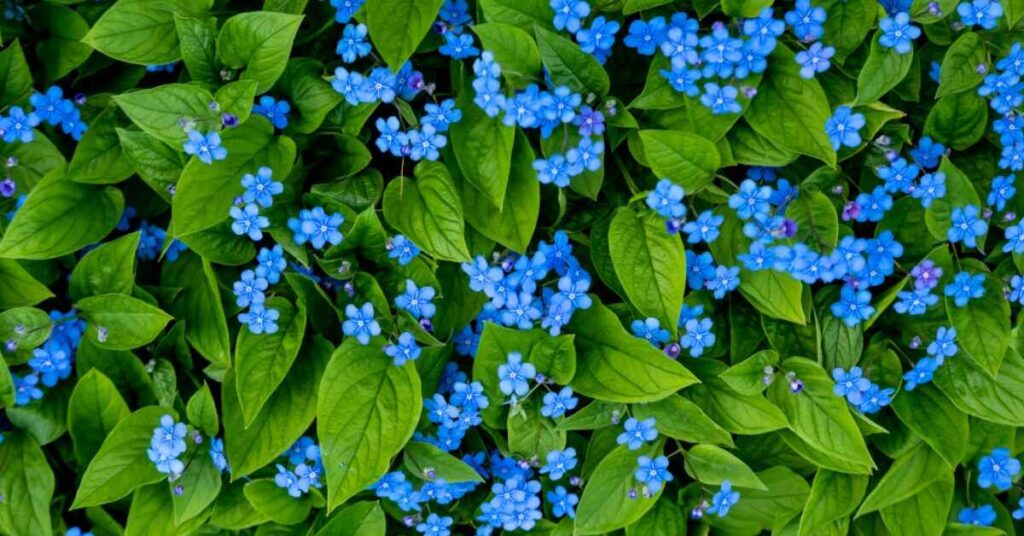
Butterfly Bush, also known as Buddleia, is a popular deciduous shrub known for its cone-shaped clusters of nectar-rich, fragrant flowers. The flowers come in a range of colors, including purple, blue, pink, and white. As the name suggests, Butterfly Bushes are a magnet for butterflies and other pollinators. They thrive in full sun and well-drained soil, making them a favorite in butterfly and hummingbird gardens. These fast-growing shrubs are available in various sizes, from compact varieties suitable for small gardens to larger ones that serve as focal points.
- Watering Needs: Regular watering, well-draining soil.
- Bloom Color: Various, including purple, blue, pink, and white.
- Hardiness Zones: 5-9.
- Mature Height: Varies by cultivar, from 3-10 feet.
- Bloom Time: Summer to fall.
- Sunlight Exposure: Full sun.
Basket of Gold (Aurinia saxatilis)
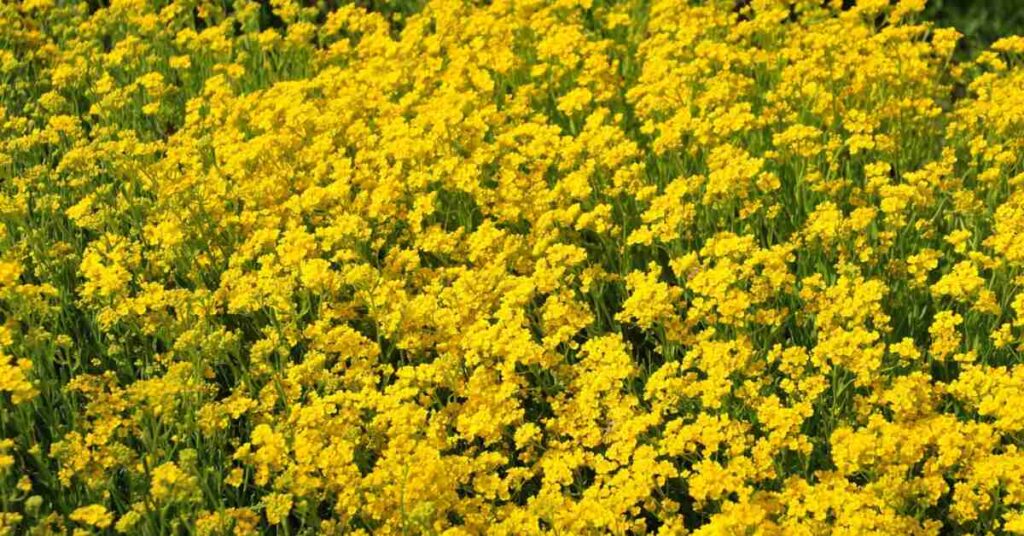
Basket of Gold, also known as Alyssum saxatile or Goldentuft, is a low-growing, evergreen perennial that produces stunning displays of bright yellow flowers in early spring. Native to Europe, it’s often used as a ground cover or in rock gardens due to its spreading habit and drought tolerance. The name “Basket of Gold” stems from its prolific, golden-yellow blooms that cascade down like a waterfall. These plants prefer full sun and well-draining soil. They’re a welcome addition to gardens looking for a burst of color during the early spring season.
- Watering Needs: Moderate watering, drought-tolerant once established.
- Bloom Color: Bright yellow.
- Hardiness Zones: 3-8.
- Mature Height: 6-12 inches.
- Bloom Time: Early spring.
- Sunlight Exposure: Full sun.
Bee Plant (Cleome serrulata)
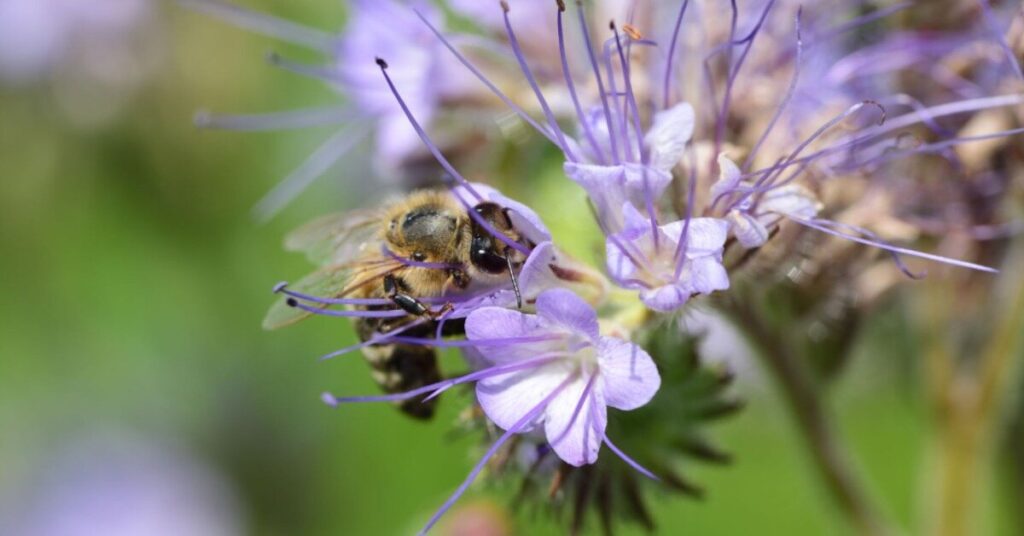
The Bee Plant, or Rocky Mountain Bee Plant, is a North American native annual with delicate, lavender-pink to white flowers that form unique spidery clusters. It’s a favorite among pollinators, including bees and butterflies, due to its abundant nectar production. Bee Plants grow in a variety of soils, including rocky and sandy areas, and can thrive in both full sun and partial shade. This drought-tolerant wildflower is an excellent choice for naturalistic gardens and meadows, attracting a multitude of beneficial insects.
- Watering Needs: Low to moderate watering, drought-tolerant.
- Bloom Color: Lavender-pink to white.
- Hardiness Zones: 3-10.
- Mature Height: 2-4 feet.
- Bloom Time: Summer.
- Sunlight Exposure: Full sun to part shade.
Blue Hibiscus (Alyogyne huegelii)
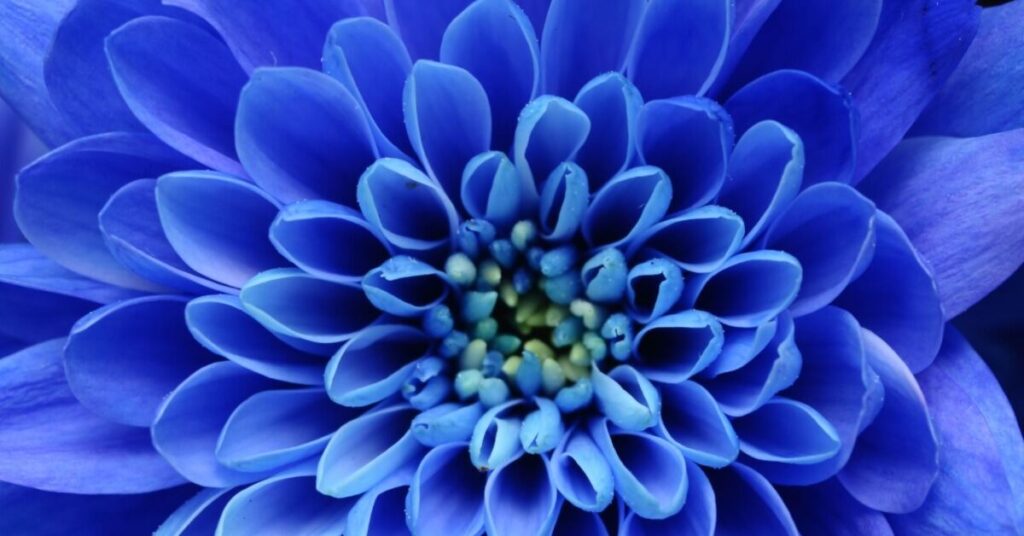
Blue Hibiscus, or Lilac Hibiscus, is a striking shrub that features large, hibiscus-like blooms in shades of blue, violet, or lilac. Despite its common name, the flower colors tend to be more in the purple spectrum. Native to Australia, it is well-suited for warm climates and thrives in full sun. Blue Hibiscus is an eye-catching addition to gardens, and its stunning blooms attract bees, butterflies, and other pollinators. The plant can reach heights of 3 to 8 feet and is cherished for its tropical appearance. Talk about a whole lot of positive energy!
- Watering Needs: Keep the soil consistently moist.
- Bloom Color: Blue, violet, lilac.
- Hardiness Zones: 9-11.
- Mature Height: 3-8 feet.
- Bloom Time: Spring to summer.
- Sunlight Exposure: Full sun.
Belladonna Lily (Amaryllis belladonna)
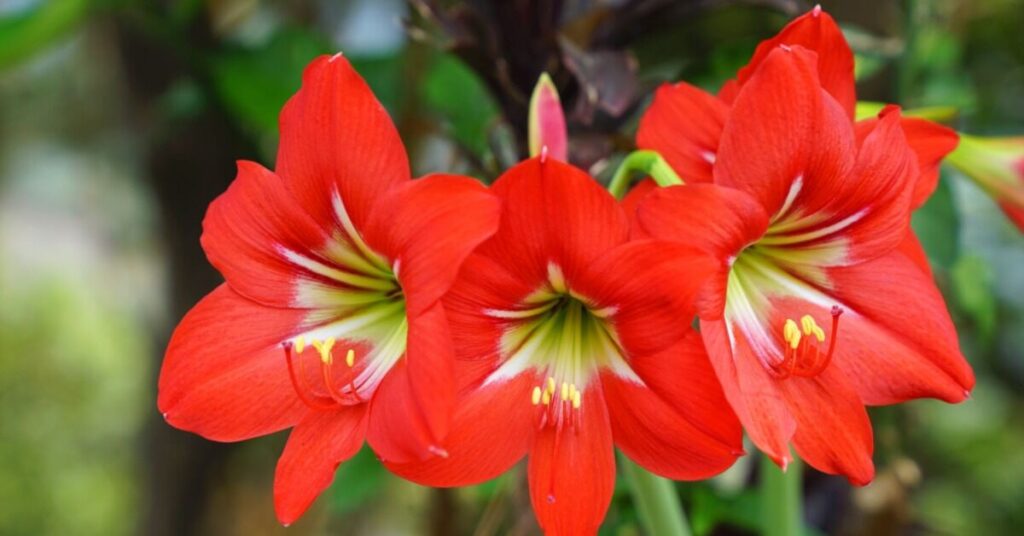
Belladonna Lily, also known as Naked Ladies, is a South African native bulbous plant. It’s famous for its fragrant, trumpet-shaped flowers that emerge on tall, leafless stems in late summer or early autumn, appearing almost magically. The blossoms come in shades of pink and white and add a touch of elegance to the garden. Belladonna Lilies prefer well-drained soil and full sun. These perennials are unique in that their foliage appears after flowering, creating a captivating seasonal display.
- Watering Needs: Keep the soil consistently moist during the growing season.
- Bloom Color: Pink.
- Hardiness Zones: 7-11.
- Mature Height: 1-2 feet.
- Bloom Time: Late summer to early autumn.
- Sunlight Exposure: Full sun to part shade.
Beardtongue (Penstemon spp.)
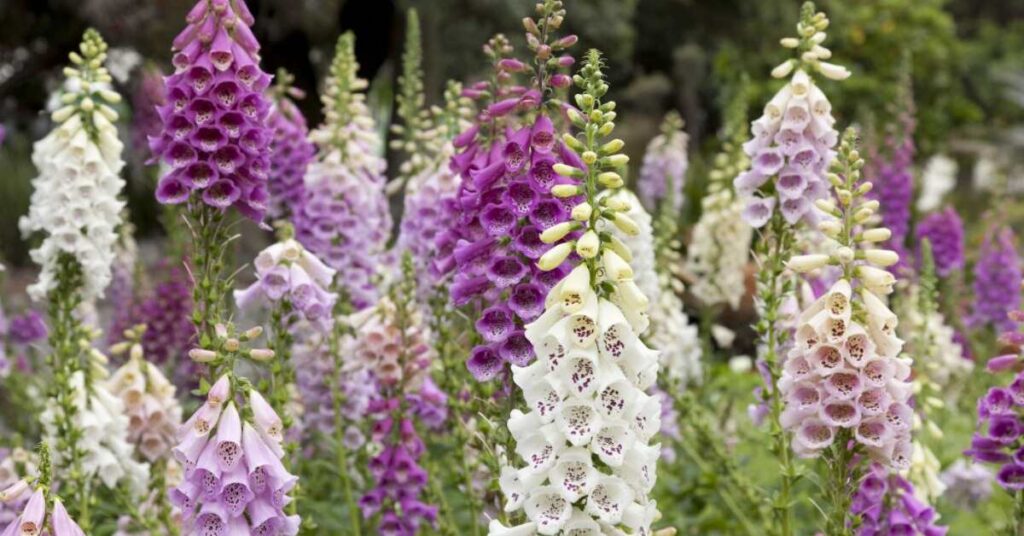
Beardtongue is a diverse genus of North American native perennials. It is known for its tubular flowers in various colors, including shades of pink, red, purple, and blue. The name “Beardtongue” comes from the small, hairy, sterile stamen that protrudes from the flower, resembling a tongue. These hardy plants adapt to different conditions and attract pollinators such as hummingbirds. Beardtongues vary in size, from compact varieties suitable for borders to tall ones that make a statement in the garden. They generally prefer full sun and well-draining soil. Based on its name, it would have to be one of the best flowers for men out there!
- Watering Needs: Moderate watering, well-draining soil.
- Bloom Color: Varies by species, including pink, red, purple, and blue.
- Hardiness Zones: 3-9.
- Mature Height: Varies by species, from 1-3 feet.
- Bloom Time: Spring to summer.
- Sunlight Exposure: Full sun.
Blue Passion Flower (Passiflora caerulea)
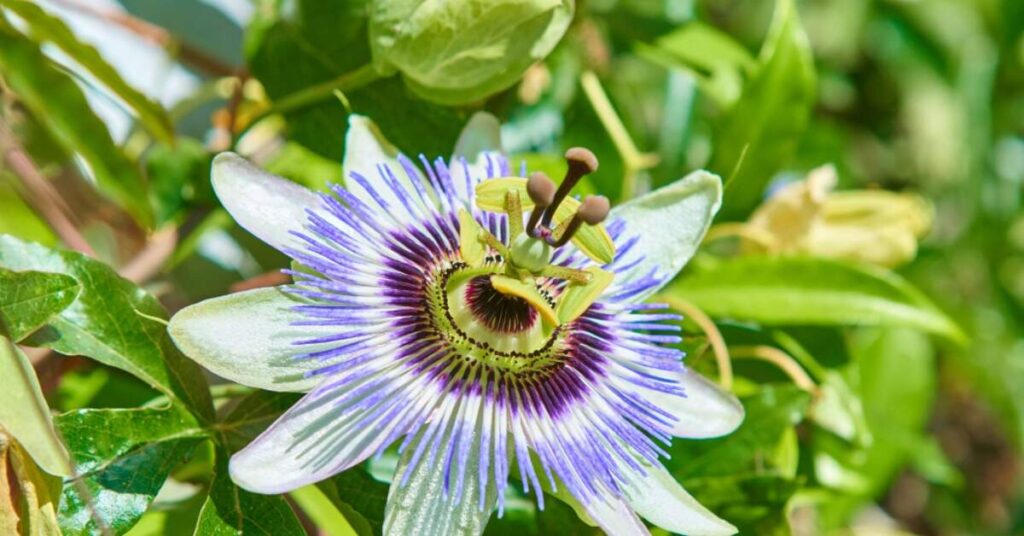
The Blue Passion Flower, or Common Passion Flower, is a vigorous vine native to South America. It is famous for its exotic, intricate, and fragrant flowers with blue or purple petals, white and purple coronas, and an array of delicate filaments. These flowers give way to edible fruit in some species. Blue Passion Flowers are hardy and adaptable, and they prefer full sun. Their unique appearance and association with passion and spirituality make them a captivating addition to gardens and trellises, attracting pollinators with their vibrant blooms.
- Watering Needs: Keep the soil consistently moist.
- Bloom Color: Blue or purple with white and purple coronas.
- Hardiness Zones: 7-11.
- Mature Height: 15-30 feet.
- Bloom Time: Summer to fall.
- Sunlight Exposure: Full sun.
Begonia (Begonia spp.)
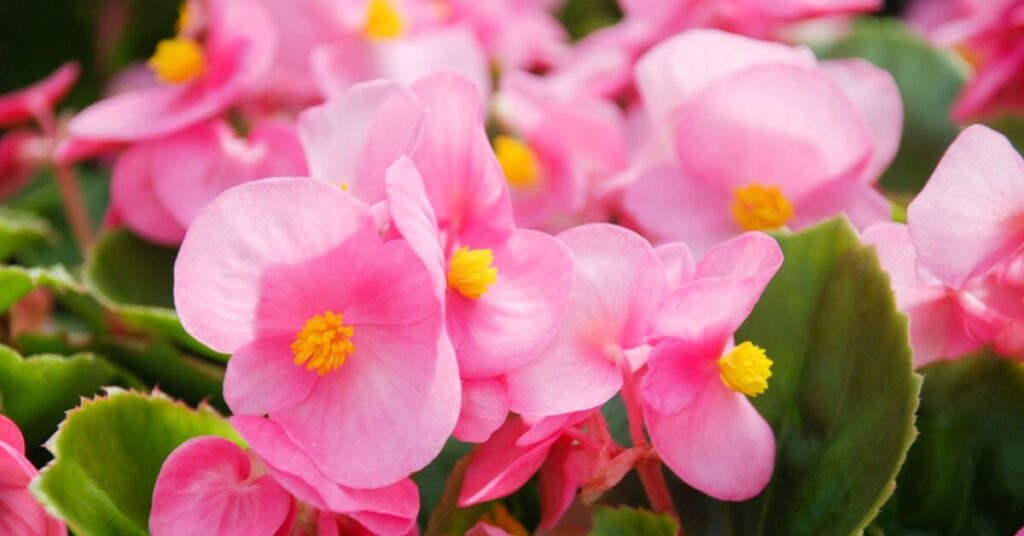
Begonias are a vast and diverse group of flowering plants, with over 1,800 species. They come in a wide range of sizes, shapes, and colors. Begonias are grown for their attractive foliage and showy, often asymmetrical flowers. They can be annuals or perennials, and some are grown as houseplants, from the delicate, tuberous begonias to the more common fibrous-rooted varieties.
- Watering Needs: Keep the soil consistently moist but not waterlogged. Begonias prefer well-draining soil.
- Bloom Color: Varied colors, including red, pink, white, and orange.
- Hardiness Zones: Typically grown as annuals or houseplants, but some are hardy in zones 6-11.
- Mature Height: Varies by species, from a few inches to several feet.
- Bloom Time: Summer to fall.
- Sunlight Exposure: Partial to full shade.
Bluebell (Hyacinthoides non-scripta)
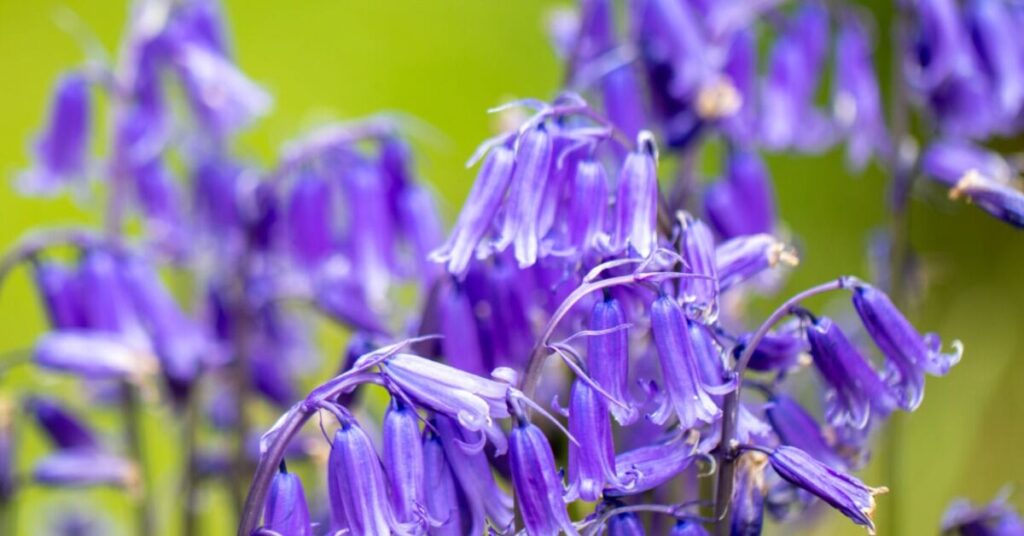
Bluebells are perennial wildflowers native to Western Europe. They typically bloom in the spring, forming dense carpets of blue or violet flowers in woodlands. They are known for their pleasant fragrance and are an essential part of British woodland landscapes. They are famous for their graceful, drooping, bell-shaped, blue or purple flowers that carpet the forest floor in the spring.
- Watering Needs: Moderate watering during the growing season.
- Bloom Color: Blue or violet.
- Hardiness Zones: 4-8.
- Mature Height: 12-18 inches.
- Bloom Time: Spring.
- Sunlight Exposure: Part shade to full shade.
Bougainvillea (Bougainvillea spp.)
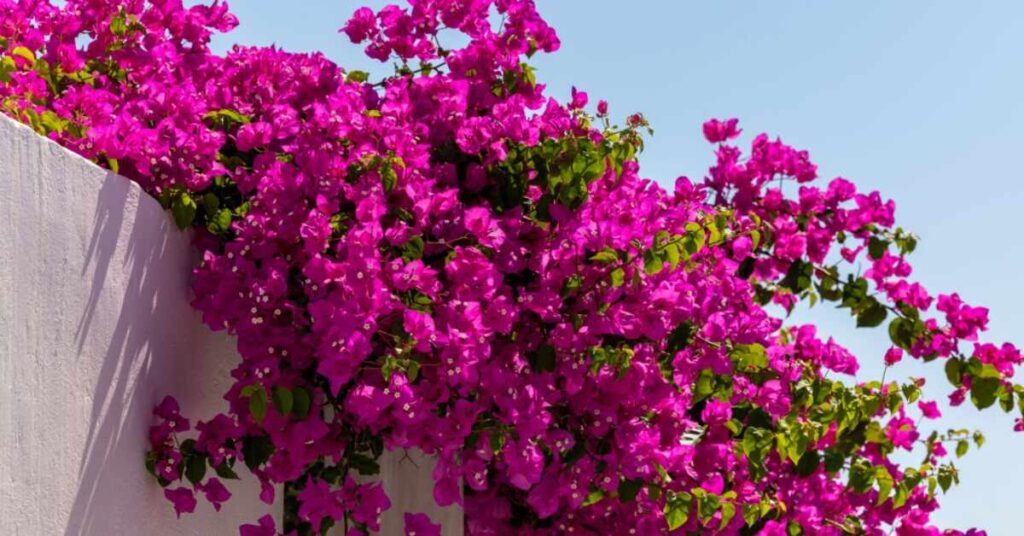
Bougainvillea is a tropical and subtropical vine known for its vibrant and papery bracts, which come in shades of red, pink, purple, orange, and white. The actual flowers are small and tubular, surrounded by these colorful bracts. Bougainvillea is a popular ornamental plant in warm climates. These vines are widely cultivated for their vibrant appearance.
- Watering Needs: Allow the soil to dry between watering.
- Bloom Color: Vibrant bracts in red, pink, purple, orange, or white.
- Hardiness Zones: Typically grown in zones 9-11.
- Mature Height: Can reach up to 20 feet.
- Bloom Time: Spring to fall.
- Sunlight Exposure: Full sun.
Buttercup (Ranunculus spp.)
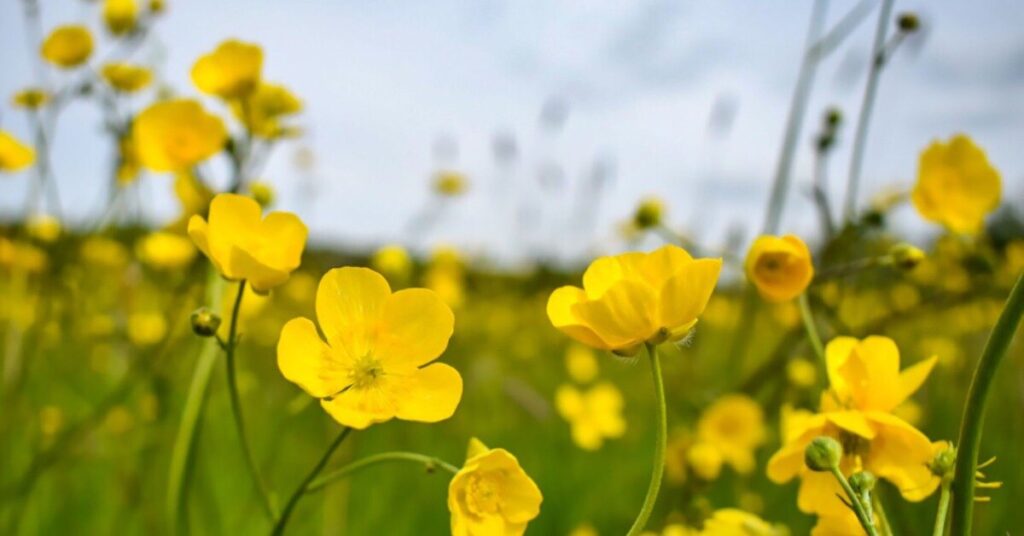
Buttercups are a genus of flowering plants comprising about 600 species. They are known for their bright yellow, shiny petals. While they are beautiful, many species contain toxins that can be harmful to livestock if ingested. They are often found in meadows and fields and are known for their cheerful appearance.
- Watering Needs: Keep the soil consistently moist.
- Bloom Color: Bright yellow.
- Hardiness Zones: Varies by species.
- Mature Height: Varies by species.
- Bloom Time: Spring to early summer.
- Sunlight Exposure: Full sun to part shade.
Bleeding Heart (Dicentra spectabilis)
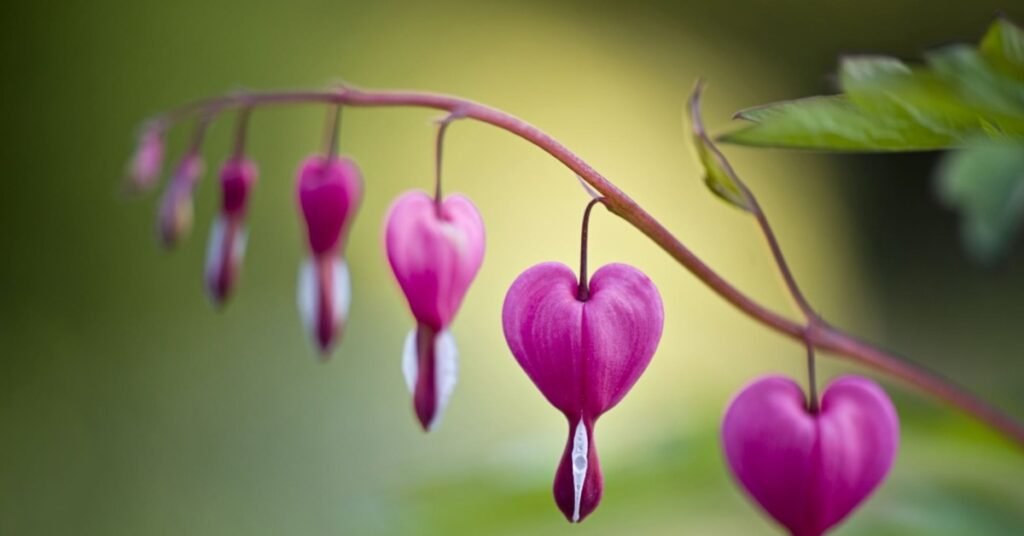
The Bleeding Heart is a herbaceous perennial known for its unique and romantically shaped flowers. They typically have pink, red, or white blooms that dangle from arching stems, creating a distinctive and captivating appearance.
- Watering Needs: Keep the soil consistently moist.
- Bloom Color: Pink, red, or white.
- Hardiness Zones: 2-9.
- Mature Height: 2-3 feet.
- Bloom Time: Spring to early summer.
- Sunlight Exposure: Part shade to full shade.
Bee Balm (Monarda didyma)
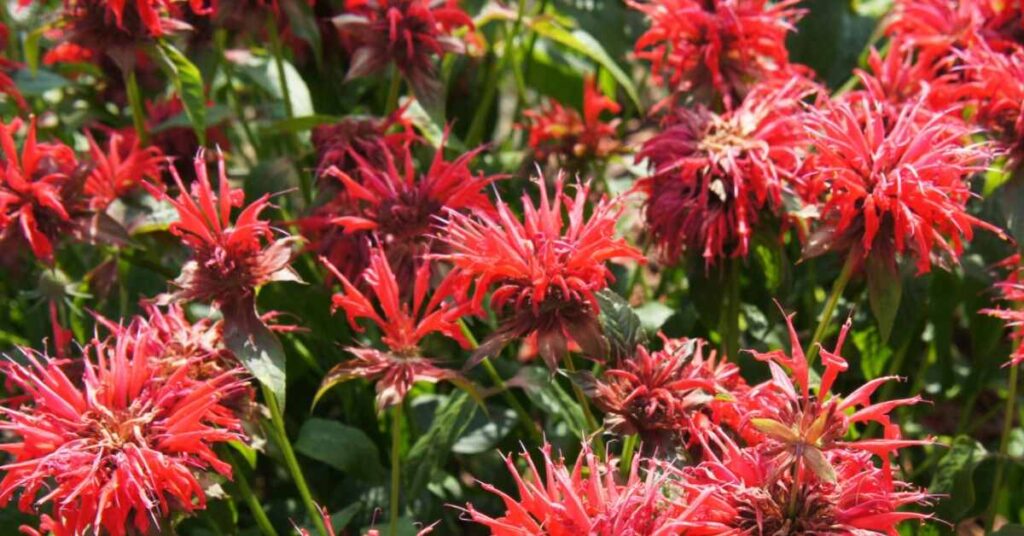
Bee Balm, or Bergamot, is a North American native perennial with spiky, tubular flowers in shades of red, pink, and purple. It’s named for its popularity with bees and other pollinators. The leaves of some species are also used for herbal teas and remedies.
- Watering Needs: Keep the soil consistently moist.
- Bloom Color: Red, pink, purple.
- Hardiness Zones: 4-9.
- Mature Height: 2-4 feet.
- Bloom Time: Summer.
- Sunlight Exposure: Full sun to part shade.
Balloon Flower (Platycodon grandiflorus)
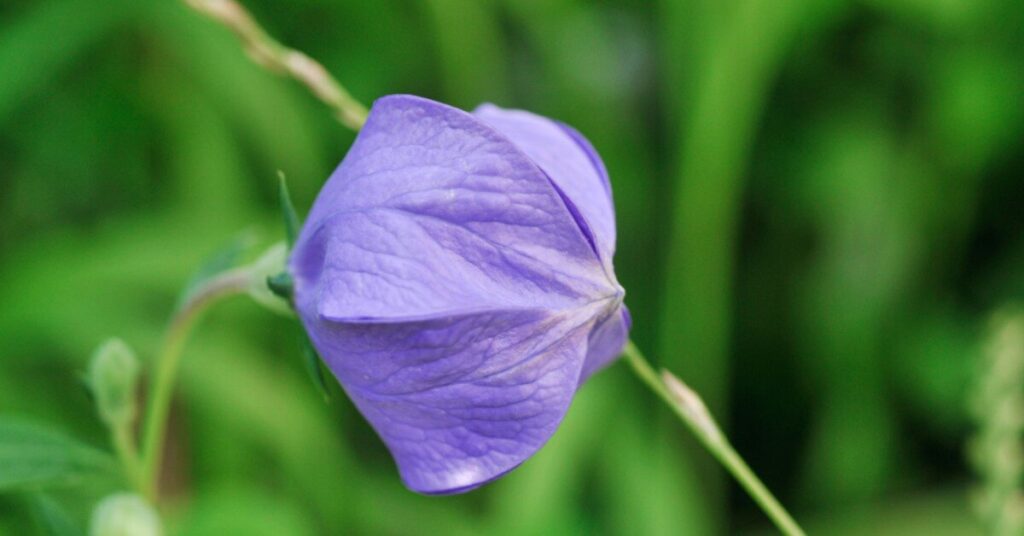
Balloon Flowers are herbaceous perennials known for their puffy, balloon-like buds that burst open to reveal star-shaped blossoms in blue, white, or pink. The unique shape of the buds adds an element of surprise to the garden.
- Watering Needs: Keep the soil consistently moist.
- Bloom Color: Blue, white, or pink.
- Hardiness Zones: 3-8.
- Mature Height: 1-3 feet.
- Bloom Time: Summer.
- Sunlight Exposure: Full sun to part shade.
Borage (Borago officinalis)
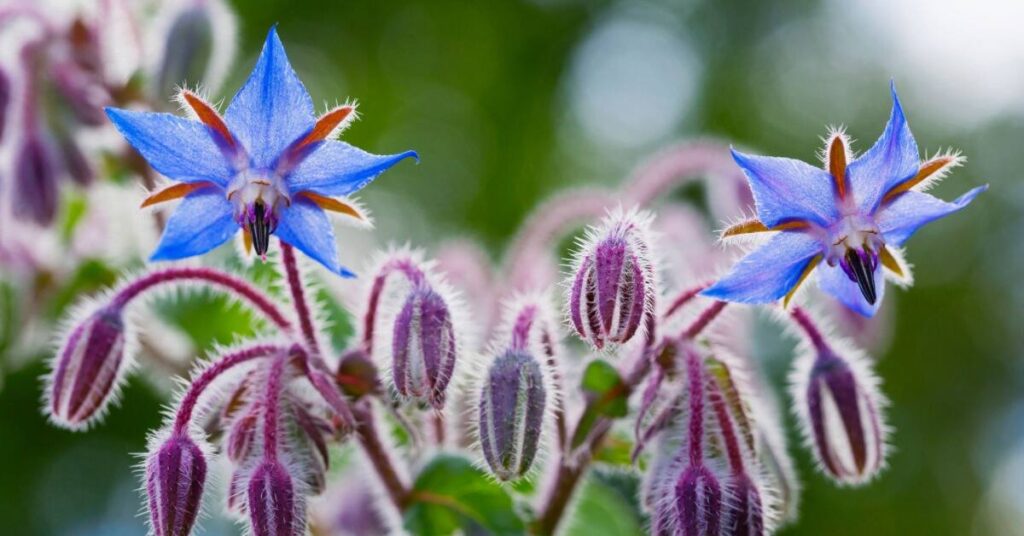
Borage is an annual herb with striking, star-shaped, bright blue flowers. It is known for its use in culinary applications, particularly in garnishing drinks and salads. Borage is also valued for its ability to attract pollinators to the garden.
- Watering Needs: Water when the soil is dry.
- Bloom Color: Bright blue.
- Hardiness Zones: Typically grown as an annual.
- Mature Height: 2-3 feet.
- Bloom Time: Summer.
- Sunlight Exposure: Full sun.
Black-eyed Susan (Rudbeckia hirta)
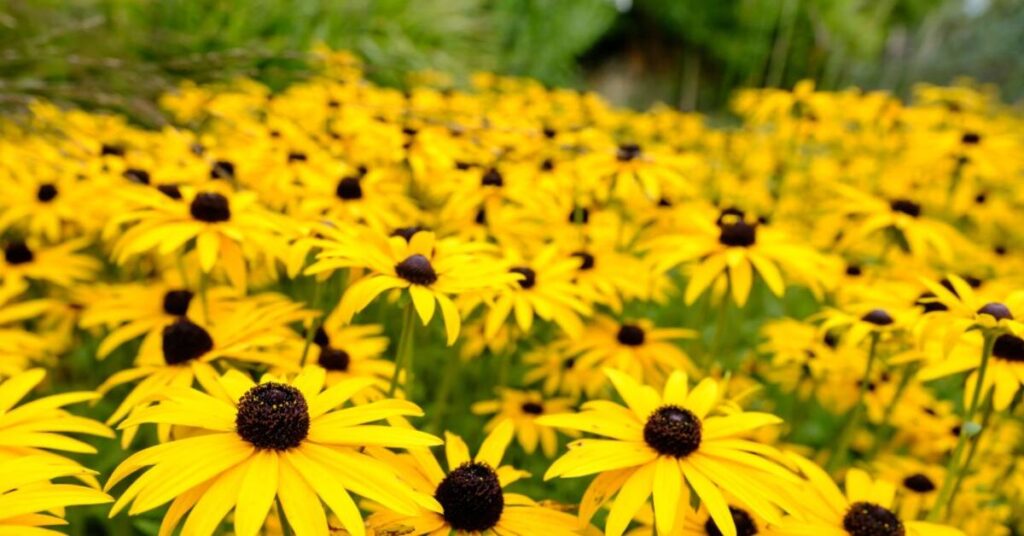
Black-eyed Susans are native wildflowers with golden-yellow or orange petals and a dark brown central cone. They are well-loved for their resilience and their ability to add a burst of color to gardens and meadows.
- Watering Needs: Tolerant of dry conditions but benefits from regular watering.
- Bloom Color: Yellow or orange with a dark center.
- Hardiness Zones: 3-7.
- Mature Height: 2-3 feet.
- Bloom Time: Summer to fall.
- Sunlight Exposure: Full sun.
Bee Orchid (Ophrys spp.)
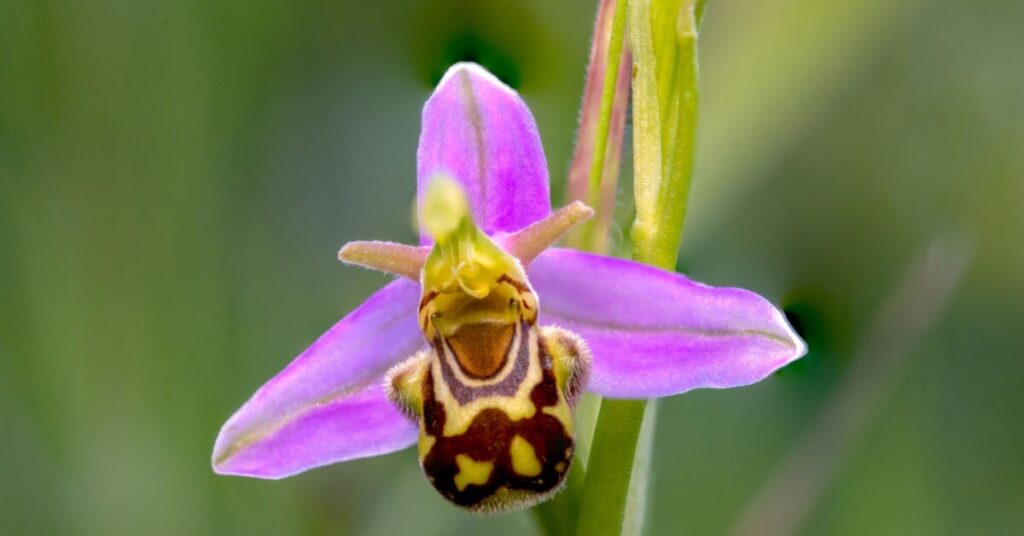
Bee Orchids are a group of orchids known for their remarkable mimicry of bees. They attract male bees by resembling a female bee, facilitating pollination. They are native to Europe and are of great interest to orchid enthusiasts and botanists.
- Watering Needs: Moderate watering during the growing season.
- Bloom Color: Varied, but often brown and yellow to mimic bees.
- Hardiness Zones: Varies by species.
- Mature Height: Varies by species.
- Bloom Time: Spring to early summer.
- Sunlight Exposure: Full sun to part shade.
Bird of Paradise (Strelitzia reginae)
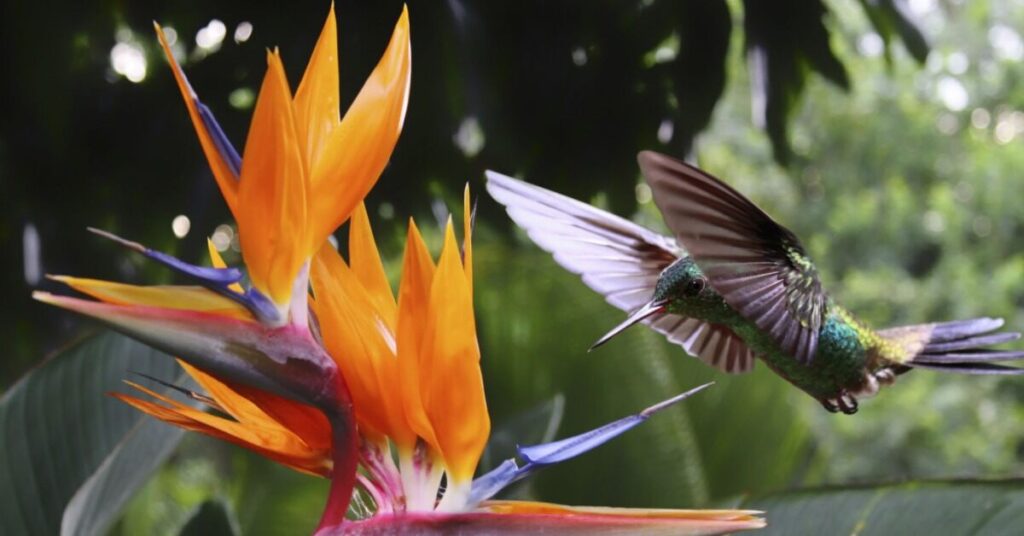
Bird of Paradise is a striking tropical plant with large, banana-like leaves and distinctive crane-shaped flowers in orange and blue. Native to South Africa, it’s a symbol of paradise and a popular choice for indoor or outdoor decoration in warm climates.
- Watering Needs: Allow the soil to dry between watering.
- Bloom Color: Orange and blue.
- Hardiness Zones: 10-12.
- Mature Height: 3-5 feet indoors, taller outdoors.
- Bloom Time: Year-round in suitable climates.
- Sunlight Exposure: Full sun to part shade.
Blanket Flower (Gaillardia spp.)
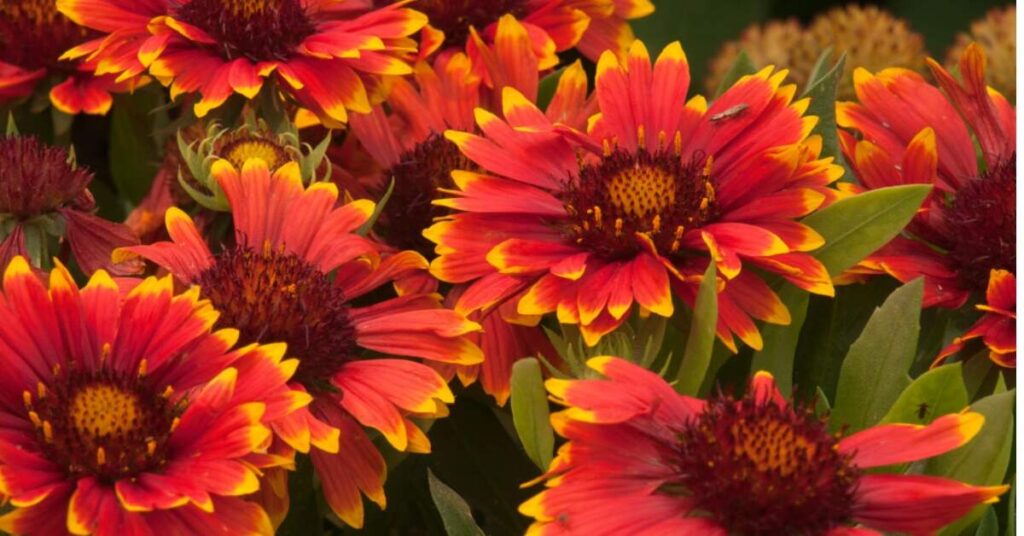
Blanket Flowers are North American native perennials known for their daisy-like, red and yellow blossoms. They are drought-tolerant and attract pollinators, making them a favorite in xeriscape gardens.
- Watering Needs: Moderate watering, drought-tolerant once established.
- Bloom Color: Red and yellow.
- Hardiness Zones: 3-10, depending on the species.
- Mature Height: 1-3 feet.
- Bloom Time: Summer to fall.
- Sunlight Exposure: Full sun.
Bellflower (Campanula spp.)
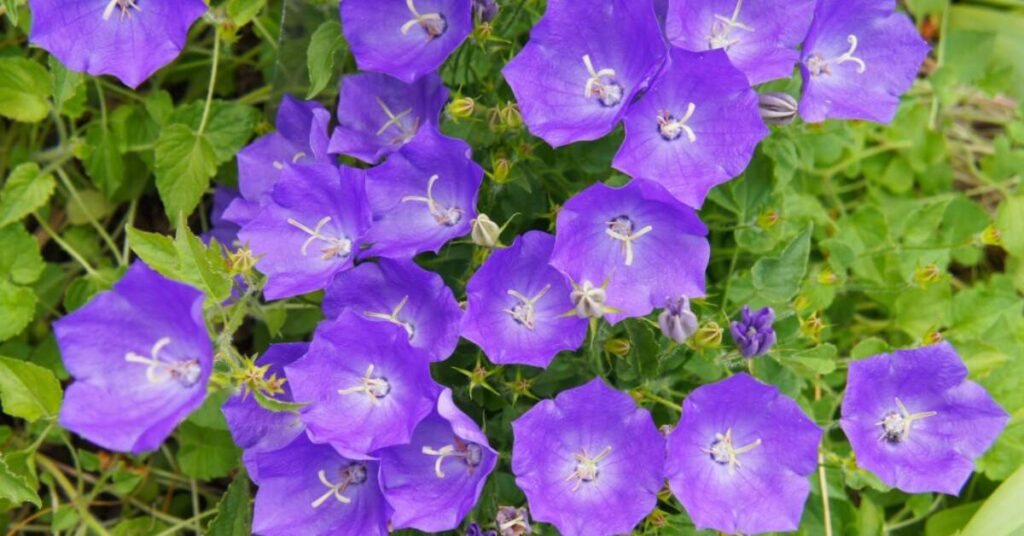
Bellflowers encompass a wide range of species, both annual and perennial. They produce charming bell-shaped flowers in various colors. Some species are compact groundcovers, while others form tall spikes.
- Watering Needs: Keep the soil consistently moist.
- Bloom Color: Varies by species, including blue, pink, and white.
- Hardiness Zones: Varies by species.
- Mature Height: Varies by species, from a few inches to several feet.
- Bloom Time: Spring to summer.
- Sunlight Exposure: Full sun to part shade.
Bachelor’s Button (Centaurea cyanus)
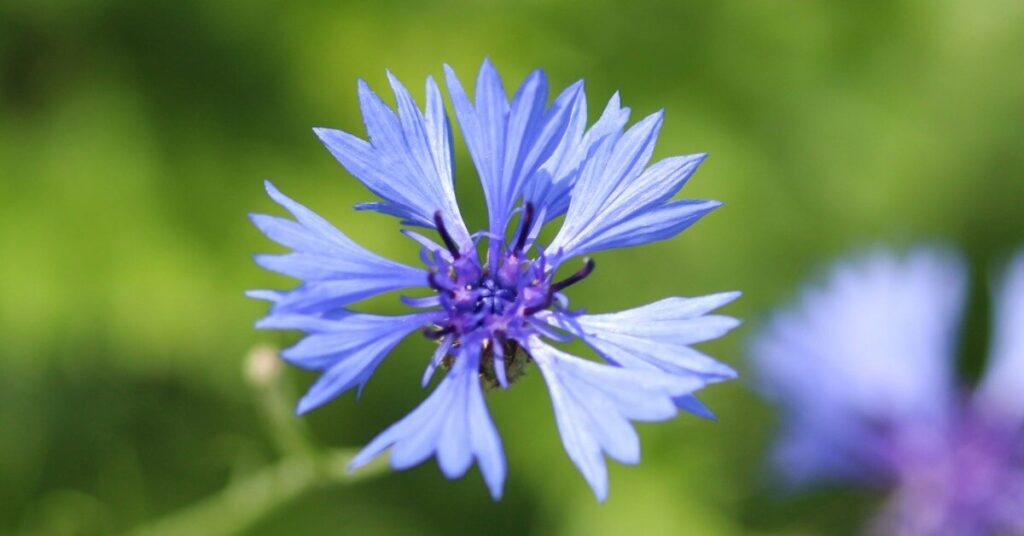
Bachelor’s Buttons, or Cornflowers, are annual wildflowers known for their bright blue, pink, or white blooms. They are often found in meadows and have been used as symbols of love and celibacy.
- Watering Needs: Moderate watering.
- Bloom Color: Blue, pink, white.
- Hardiness Zones: 2-11, depending on the species.
- Mature Height: 1-3 feet.
- Bloom Time: Late spring to early summer.
- Sunlight Exposure: Full sun.
Blephilia (Blephilia spp.)
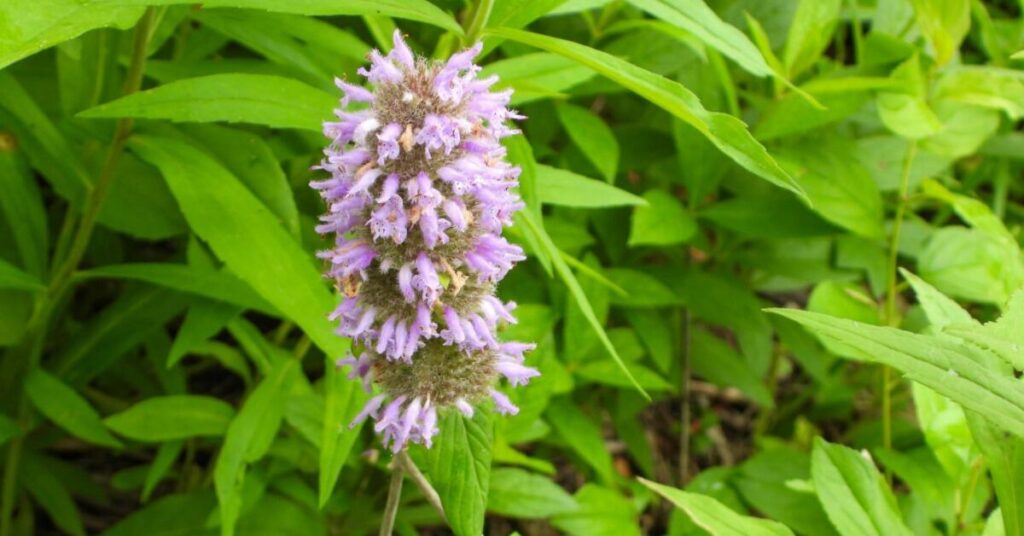
Blephilia is a genus of wildflowers native to North America. They have tubular, lavender to pink flowers and are known for attracting pollinators, especially bees and butterflies. These plants play a vital role in local ecosystems.
- Watering Needs: Keep the soil consistently moist.
- Bloom Color: Lavender to pink.
- Hardiness Zones: 3-8, depending on the species.
- Mature Height: Varies by species.
- Bloom Time: Late spring to summer.
- Sunlight Exposure: Full sun to part shade.
Blazing Star (Liatris spp.)
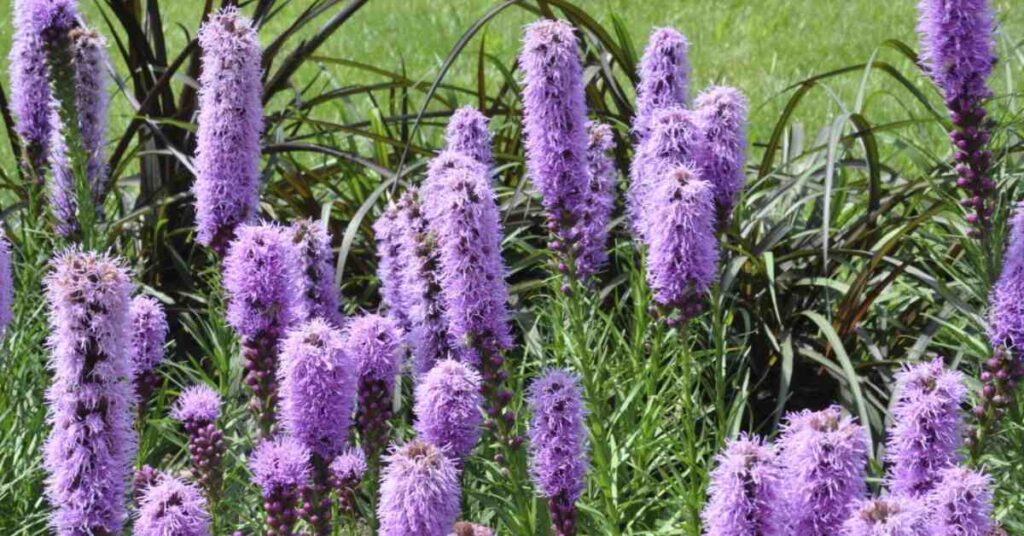
Blazing Stars, or Liatris, are North American native perennials with tall spikes of purple, pink, or white florets. They are attractive to butterflies, particularly Monarchs, and are excellent for late-summer garden displays.
- Watering Needs: Keep the soil consistently moist.
- Bloom Color: Purple, pink, or white.
- Hardiness Zones: 3-9, depending on the species.
- Mature Height: 1-5 feet.
- Bloom Time: Summer to fall.
- Sunlight Exposure: Full sun.
Baby’s Breath (Gypsophila spp.)
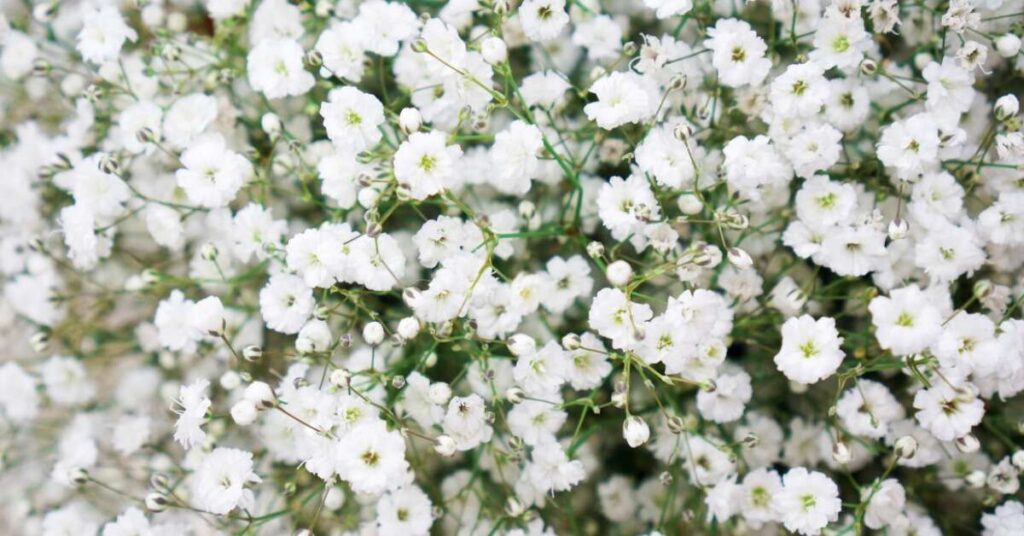
Baby’s Breath is known for its delicate, tiny, white or pink flowers. Often used as a filler in floral arrangements, it imparts a sense of lightness and elegance to bouquets. It’s also a symbol of pure and everlasting love.
- Watering Needs: Moderate watering.
- Bloom Color: White or pink.
- Hardiness Zones: 3-9, depending on the species.
- Mature Height: 6 inches to 3 feet.
- Bloom Time: Summer.
- Sunlight Exposure: Full sun.
Balsam (Impatiens balsamina)
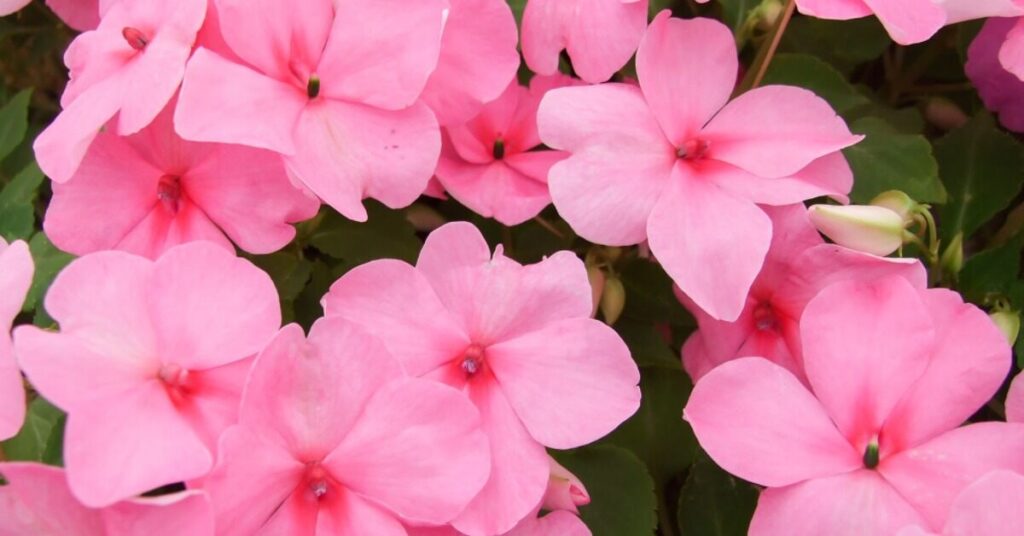
Balsam, or Garden Balsam, is an annual plant with colorful, single or double camellia-like flowers in shades of pink, red, or white. They are easy to grow and are commonly used in gardens and as bedding plants. It’s a great native plant for any garden!
- Watering Needs: Keep the soil consistently moist.
- Bloom Color: Varied colors, including pink and red.
- Hardiness Zones: Typically grown as an annual.
- Mature Height: 1-3 feet.
- Bloom Time: Summer to fall.
- Sunlight Exposure: Part shade to full shade.
Beehive Ginger (Zingiber spectabile)
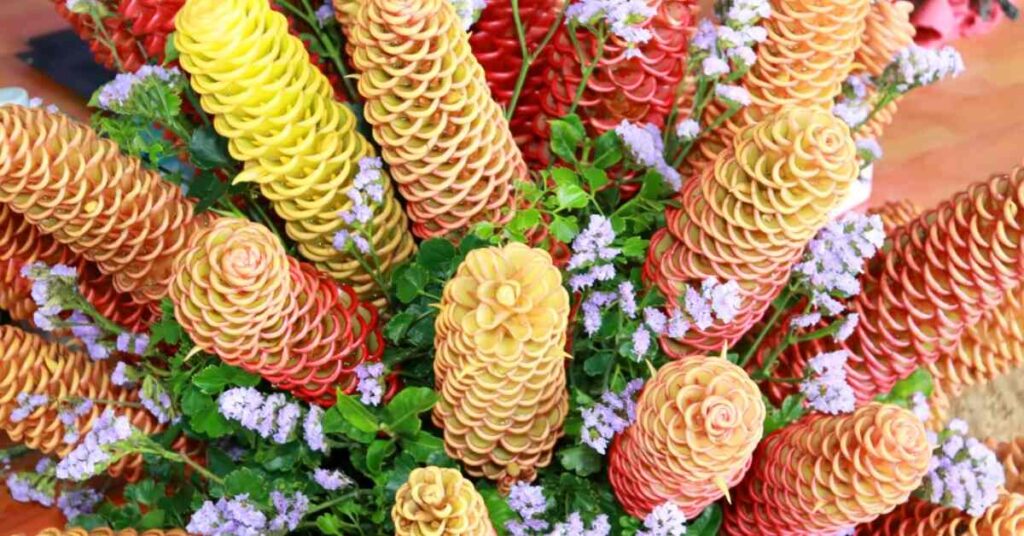
Beehive Ginger is a tropical plant known for its showy, beehive-shaped bracts. These bracts are green, turning red as they mature. The actual flowers are small and inconspicuous. It’s a unique and captivating addition to tropical gardens.
- Watering Needs: Keep the soil consistently moist.
- Bloom Color: Beehive-like bracts that start green and turn red.
- Hardiness Zones: 9-11.
- Mature Height: 4-6 feet.
- Bloom Time: Summer.
- Sunlight Exposure: Part shade to full shade.
Brazilian Plume Flower (Justicia carnea)
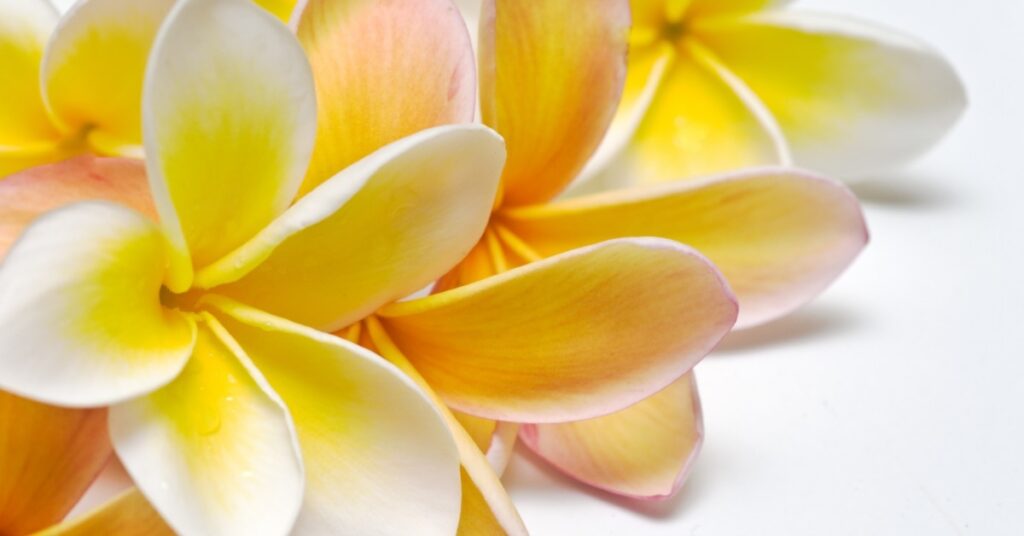
Brazilian Plume Flower, or Flamingo Flower, is a tropical shrub native to Brazil. It produces tall spikes of tubular pink or white blossoms, attracting hummingbirds with its nectar. It’s prized for its striking appearance and lush, tropical foliage. It also happens to be bee-friendly!
- Watering Needs: Keep the soil consistently moist.
- Bloom Color: Pink or white.
- Hardiness Zones: 10-11.
- Mature Height: 4-8 feet.
- Bloom Time: Spring to fall.
- Sunlight Exposure: Full sun to part shade.
